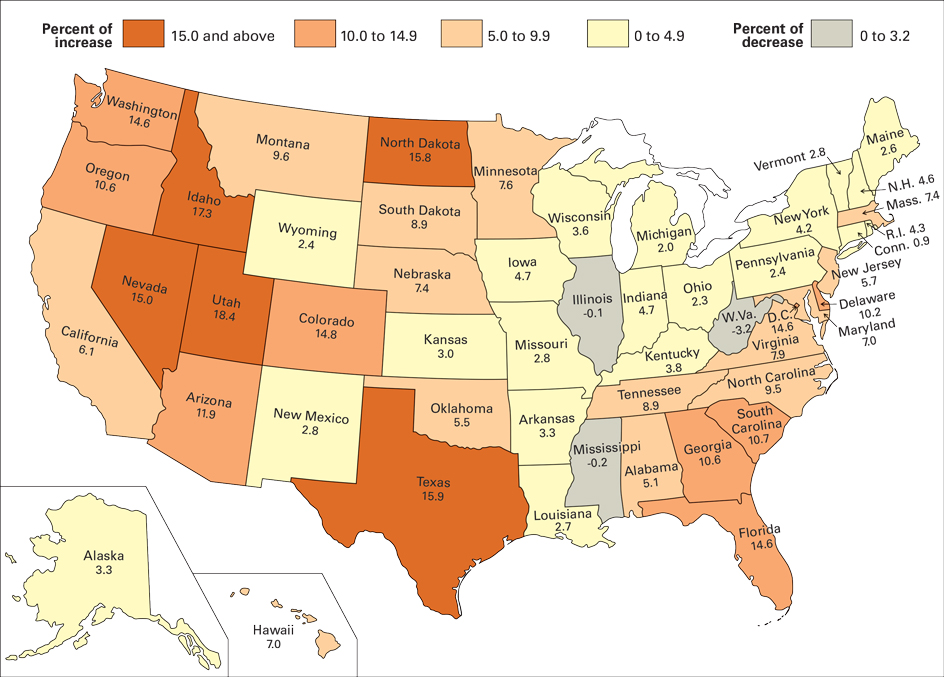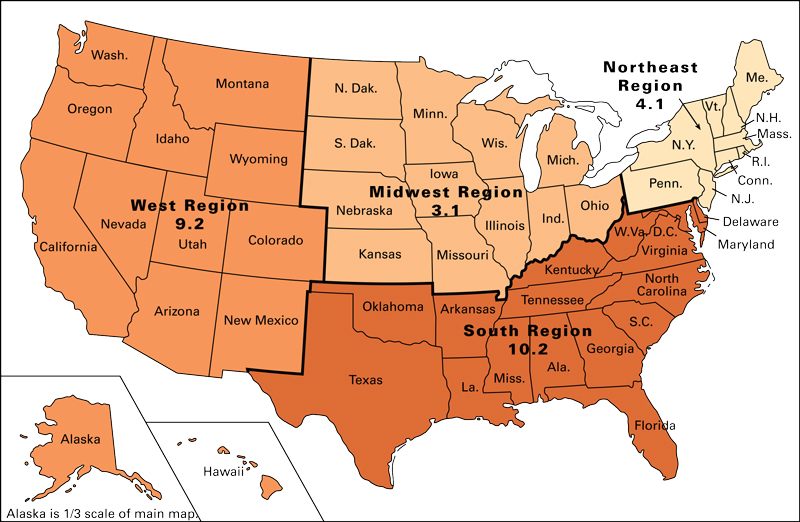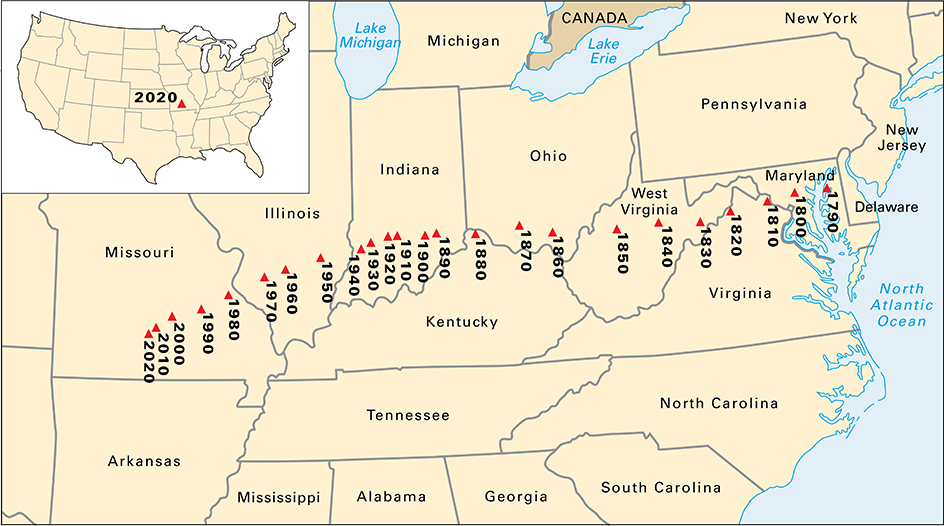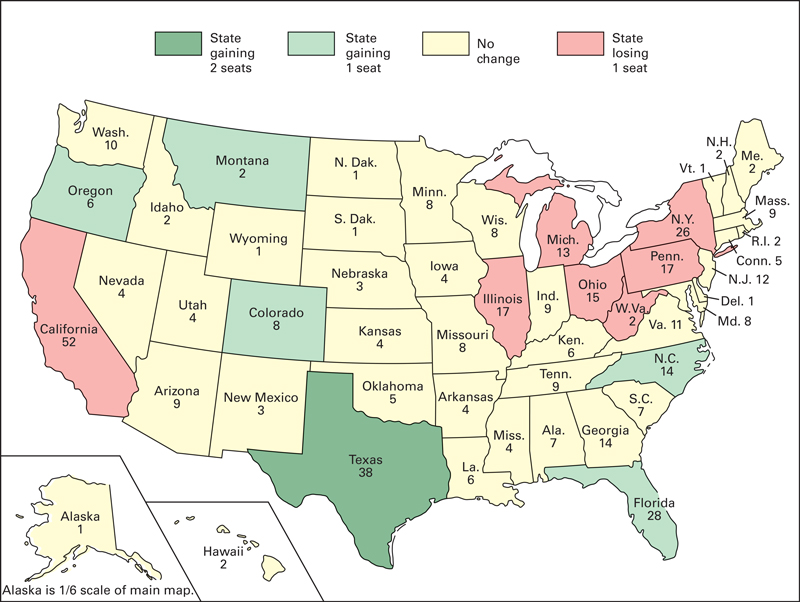United States census of 2020 was an extensive nationwide information-gathering project conducted by the U.S. federal government. The Census Bureau carries out a census of population and housing every 10 years. The bureau is an agency of the U.S. Department of Commerce. Census taking, also called enumeration, enables the government to obtain a current description of the people of the United States. This description includes the size of the population, as well as such facts as age, ethnicity, race, and sex. Because of its 10-year cycle, the U.S. census is called a decennial census. The 2020 census was the 24th U.S. decennial census. The first one took place in 1790. 
Census information helps government agencies administer programs, distribute funds, and study social and economic problems. Statistics provided by the census affect the distribution of government money for economic development, housing, school aid, welfare, and Social Security. In addition, population size determines the number of representatives each state will have in the U.S. House of Representatives. Lawmakers also use population totals to draw boundaries for electoral districts.
Planning, conducting, and processing a census is a difficult and expensive project. The census of 2020 employed about half a million people and was estimated to cost about $16 billion.
Conducting the 2020 census
Early planning for the 2020 census began while the 2010 census was still underway. During the 2010 census, the Census Bureau gathered ideas for how to improve the process.
Assembling a work force.
In preparation for the 2020 census, the Census Bureau established 6 regional census centers and 248 area census offices. Many permanent Census Bureau employees were assigned to key positions in these field offices. A major task for the field offices was to recruit and train hundreds of thousands of temporary employees.
The Census Bureau conducted one “dress rehearsal” census in 2018. This rehearsal was held in Providence County, Rhode Island. The bureau used this rehearsal to test procedures and to identify and correct problems.
Questionnaire.
For all censuses from 1960 to 2010, the Census Bureau mailed out lists of questions and asked the public to complete them and mail them back. In 2020, the bureau mailed out invitation letters and asked the public to respond to the census either online or by phone. They also mailed out questionnaires to some homes in areas with low internet access. The 2020 census was the first census to allow people to respond online.
Since 2010, the Census Bureau has used a single list of questions called the short-form questionnaire. This questionnaire asks a small number of basic questions. It asks the same questions of all households. Items on the questionnaire include the names of people in the household, their ages, and their race or Hispanic ethnicity. The questionnaire also asks whether the housing unit is owned or rented.
From 1940 to 2000, the Census Bureau had also used a long-form questionnaire. This questionnaire included additional social, economic, and housing questions. These questions were asked of only a sample of all households. In 2005, the bureau replaced the long-form questionnaire with the American Community Survey (ACS). The ACS is a permanent sample survey that collects certain data annually. One advantage of the American Community Survey is timeliness. A continuously running survey produces more current results than a census taken every 10 years.
Some Americans argue that the Constitution of the United States calls only for a head count. They claim that other questions are an invasion of privacy. However, many courts have ruled that it is constitutional to collect various statistics in the census.
Distributing forms.
A key resource for conducting a census is the master address file, a listing of about 150 million addresses. An accurate address list makes it possible to reach a high percentage of households with the first mailing of invitation letters and questionnaires. Reaching households through the mail reduces the cost of having individual enumerators (census takers) find residences and ask questions in person.
In mid-March 2020, the Census Bureau mailed out the invitation letters and questionnaires. Recipients were asked to make all answers accurate as of Census Day, April 1, 2020. In early April, the Census Bureau mailed paper questionnaires to homes that had not yet completed the census.
The Census Bureau made arrangements to reach people who do not live in individual houses or apartments. The census identifies these people as living in group quarters. Examples of group quarters include college dormitories and prisons. Instead of mailing the questionnaire, the Census Bureau visited the locations and distributed the forms. Census workers then collected the completed forms. Another special program was designed for counting homeless people. The bureau counted people staying at shelters and other sites where homeless people are known to spend the night.
Prompting response.
An extensive publicity campaign encouraged response to the census. The Census Bureau established partnerships with local governments, schools, community organizations, and other institutions to distribute information about the census. In addition, the bureau, with congressional approval, used paid advertising to encourage response. The bureau spent hundreds of millions of dollars on television, radio, and print advertisements. The Census Bureau also offered assistance by telephone, over the internet, and at Mobile Questionnaire Assistance events.
Collecting responses.
By mid-April, about half of the households had completed the census either online, by phone, or by returning a paper questionnaire. By the end of the census, about two-thirds of the households had responded in one of those ways. Although the self-response rate was high, it still left about one-third of households that had not returned their information.
The bureau’s nonresponse follow-up program obtained the missing information. Due to the COVID-19 pandemic, the Census Bureau delayed nonresponse follow-up until July, later than in previous censuses. From July through October, enumerators visited the addresses for which no response had been received. If an adult member of a household was located, the enumerator asked him or her to answer the questions for each member of the household. In some cases, enumerators returned to an address several times in an effort to find someone at home. The Census Bureau estimated that about 99.98 percent of all housing units and addresses in the country were accounted for in the 2020 census.
Releasing information.
The Census Bureau was originally scheduled to deliver state data to the president of the United States by Dec. 31, 2020. However, due to delays caused by the COVID-19 pandemic and some irregularities that the bureau discovered among the data, the Census Bureau was unable to meet this deadline.
After processing the data it collected, the Census Bureau delivered state population counts to the president on Apr. 26, 2021. Official counts for counties, cities, townships, and all other political jurisdictions were scheduled to be released beginning in August 2021. The bureau was also to release data for millions of geographic areas, such as city blocks and their equivalents in rural areas. The Census Bureau planned to release further information as processing was completed. More information about the 2020 census is available at https://www.census.gov.
An overview of census results
The official count of the population of the United States on April 1, 2020, was 331,449,281. This marked an increase of 7.4 percent over the 2010 census count of 308,745,538. The population growth rate was the lowest census-to-census increase since the Great Depression.
Population distribution.
Every state except Illinois, Mississippi, and West Virginia gained population during the 2010’s. However, some regions showed more growth than others. The South as a whole grew 10.2 percent, the West 9.2 percent, the Northeast 4.1 percent, and the Midwest 3.1 percent. Of the 15 states with the highest population growth rates,14 were in the West and the South. In total numbers, the South remained the most populated region, with 126.2 million people. It was followed by the West with 78.6 million, the Midwest with 69.0 million, and the Northeast with 57.6 million.


The fastest rates of growth occurred in the states of Utah (18.4 percent), Idaho (17.3 percent), and Texas (15.9 percent). The largest numerical increases were in Texas (4.0 million), Florida (2.7 million), and California (2.3 million). Nearly 40 percent of the total U.S. population growth from 2010 to 2020 occurred in just these three states. One other state, Georgia, increased by at least 1 million people.
Many large cities had population increases during the 2010’s. For example, New York City, the nation’s largest city, gained about 629,000 people, for a total of 8,804,190. Phoenix was the fastest-growing of the 10 largest cities. Its population grew by 11 percent, from 1,445,632 people in 2010 to 1,608,139 people in 2020. Each of the 10 largest cities gained population in the 2010’s.
Race and Hispanic ethnicity.
The largest racial group in 2020 was the white population. The white population numbered 204.3 million (61.6 percent of the total U.S. population). The Black population totaled 41.1 million (12.4 percent). The Asian population was 19.9 million (6.0 percent). The American Indian and Alaska Native population was 3.7 million (1.1 percent). The population of Native Hawaiian and other Pacific Islanders was 0.7 million (0.2 percent). The 2020 census reported 27.9 million people (8.4 percent) belonging to an unspecified other race. Nearly all of these people indicated Hispanic ethnicity on the separate ethnicity question.
The census found that 34 million people (10.2 percent) identified themselves as belonging to more than one race. This was a significant increase over 2010, when 9 million people (2.9 percent) identified themselves as belonging to more than one race. The Census Bureau believes that this increase is largely due to improvements in how the census questionnaire was designed. In addition, the country’s demographics changed during the 2010’s.
The number of people who reported Hispanic ethnicity was 62.1 million (18.7 percent of the total U.S. population). The 2010 census marked the first census in which Hispanic people were the largest minority. Hispanic people were, again, the largest minority in 2020. They accounted for about 50 percent of the total population growth in the United States from 2010 to 2020. Over 40 percent of Hispanic people lived in California or Texas. Many other Western states also had a large Hispanic population.
In the 2020 census, about 41 million people identified themselves as Black. Another 5.8 million people reported that they were Black and in addition belonged to one or more other races. Black people accounted for over a quarter of the population of Alabama, Georgia, Louisiana, Maryland, Mississippi, and Washington, D.C.
Reapportionment and redistricting.
For reapportionment of Congress, each state’s population count included the totals of U.S. government personnel (both military and civilian) living overseas, as well as their dependents. The apportionment counts for states were then entered into a formula that determined how many seats in the House of Representatives each state would have.

Congress ordered the inclusion of overseas government personnel and their dependents for apportionment purposes. However, it did not order that other U.S. citizens on long overseas stays be counted. As a result, people who were living abroad as students or retirees or who were on temporary employment overseas were not counted. Many people argued that this procedure was unfair.
As a result of the 2020 census counts, 37 states kept the same number of seats in the House of Representatives as they had before. The remaining 13 states either gained or lost seats. Texas gained two seats. Colorado, Florida, Montana, North Carolina, and Oregon each gained one. California, Illinois, Michigan, New York, Ohio, Pennsylvania, and West Virginia each lost one.
Redistricting refers to the drawing of new boundaries to define electoral districts. Each congressional district is required to be redrawn before the 2022 elections so that it will be of the same population size as other districts within the state, using counts from the 2020 census. Census information also determined redistricting for thousands of election districts for state senates, state assemblies, city councils, and other government bodies.
Redistricting is a controversial political process. It provides an opportunity for those in power to draw boundaries that include or exclude city blocks and neighborhoods that are expected to vote one way or another.
